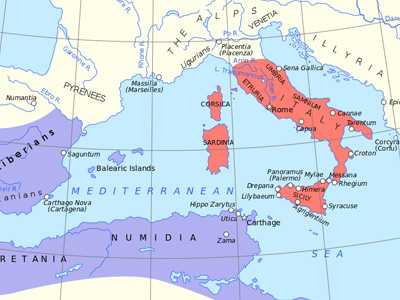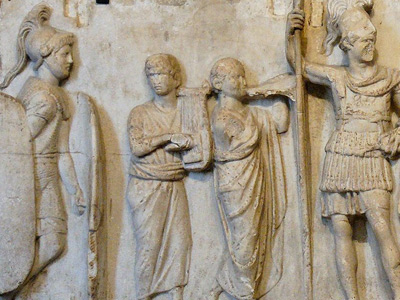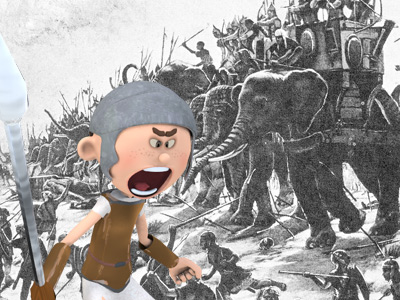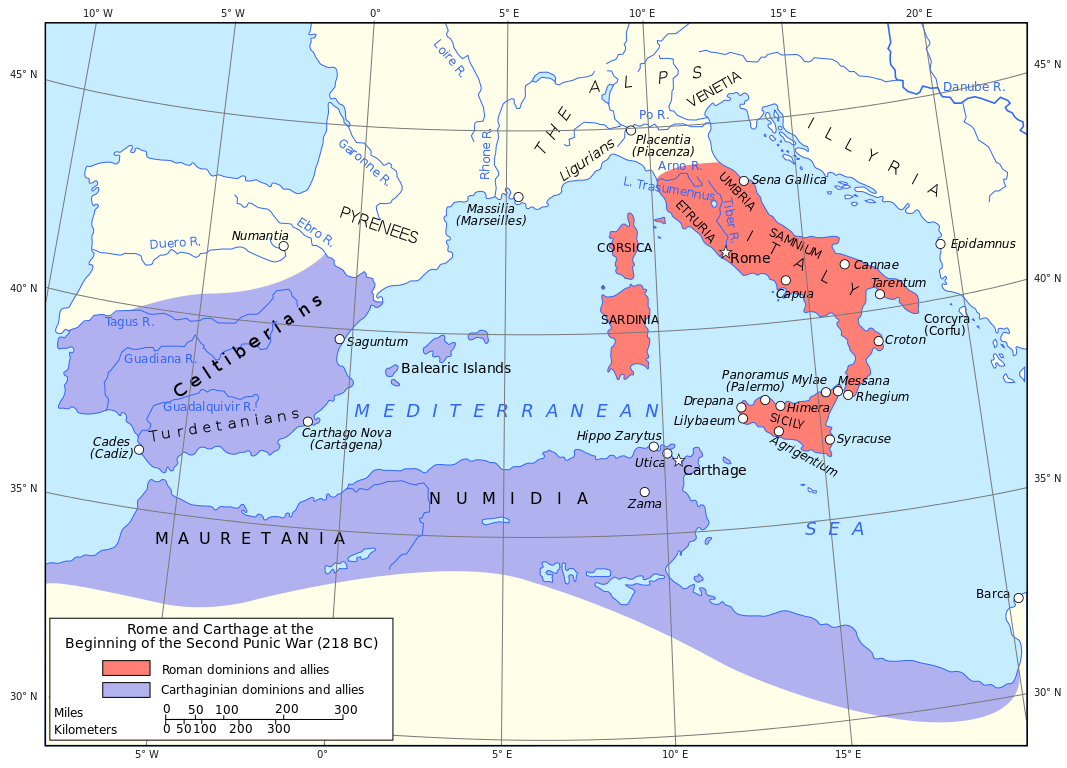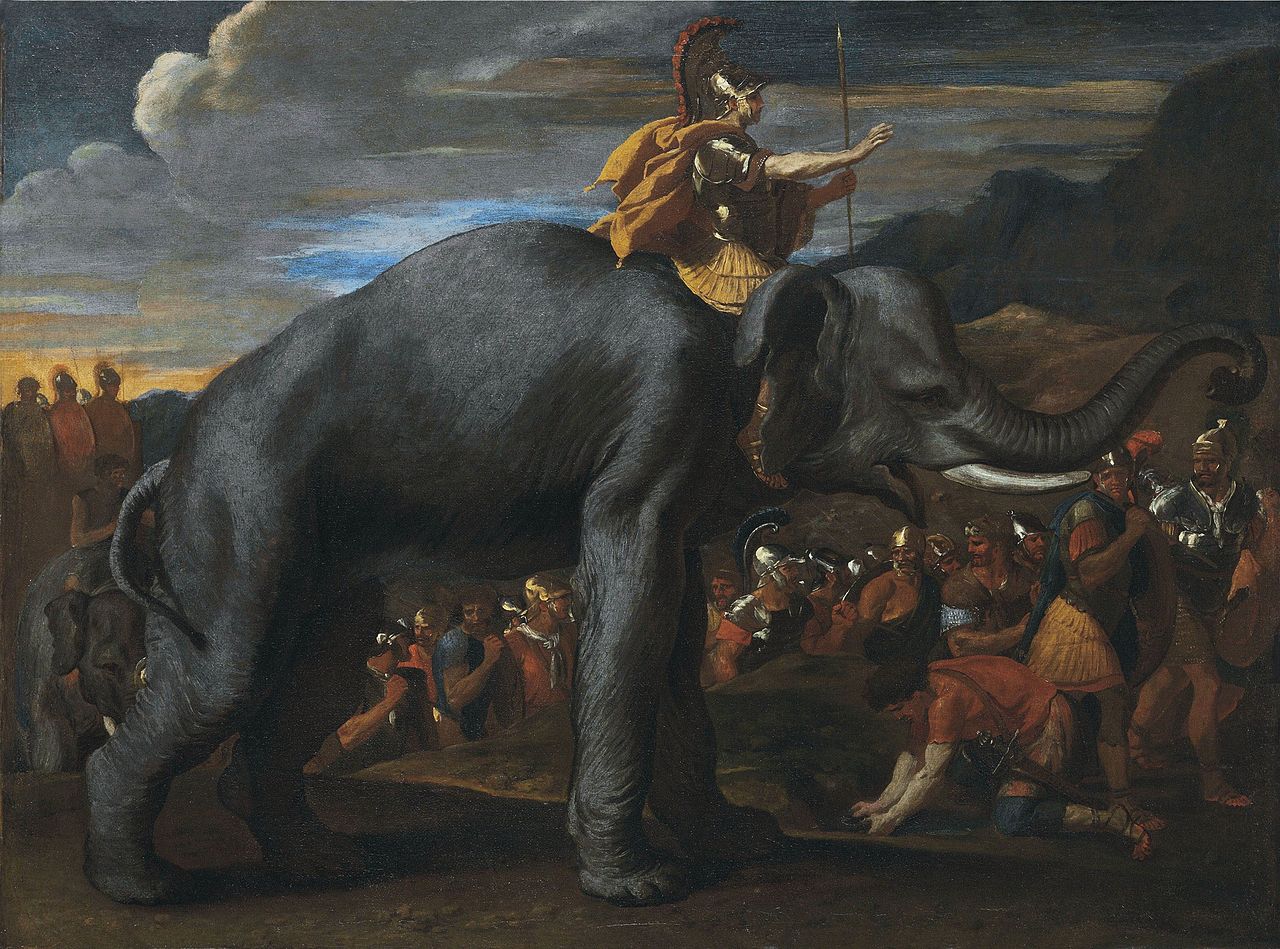Second Punic War (218-201 BC)
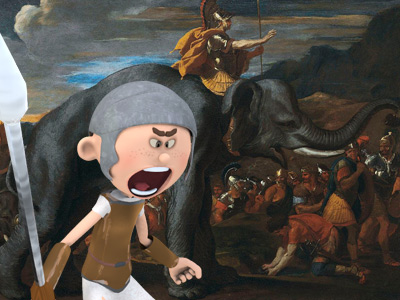
Gallic Uprising
The Romans simultaneously received news of Hannibal's crossing of the Ebro and of an uprising in northern Italy of the Gallic tribes Boii and Insubres. These had established diplomatic contact with the Carthaginians and joined them as allies against their common enemy, Rome. The first objective of the insurgents were the Roman colonies of Placentia and Cremona, causing the Romans The Roman Republic was a form of government of Rome and the era of the classical Roman civilization when it was run through public representation of the Roman people. Beginning with the overthrow of the Roman Kingdom (traditionally dated to 509 BC) and ending in 27 BC with the establishment of the Roman Empire, Rome's control rapidly expanded during this period - from the city's immediate surroundings to hegemony over the entire Mediterranean world. to flee to Mutina (modern Modena), which the Gauls then besieged. In response, Praetor L. Manlius Vulso marched with two legions and allies, for a total of 1,600 cavalry and 20,000 infantry, to Cisalpine Gaul. This army was ambushed twice on the way from Ariminium, losing 1,200 men; although the siege of Mutina was raised, the army itself fell under a loose siege a few kilometers from Mutina. This event prompted the Roman Senate to send one of Scipio's legions and 5,000 allied troops to aid Vulso. Scipio had to raise fresh troops to replace these and thus could not set out for Iberia until September 218 BC, giving Hannibal
The Roman Republic was a form of government of Rome and the era of the classical Roman civilization when it was run through public representation of the Roman people. Beginning with the overthrow of the Roman Kingdom (traditionally dated to 509 BC) and ending in 27 BC with the establishment of the Roman Empire, Rome's control rapidly expanded during this period - from the city's immediate surroundings to hegemony over the entire Mediterranean world. to flee to Mutina (modern Modena), which the Gauls then besieged. In response, Praetor L. Manlius Vulso marched with two legions and allies, for a total of 1,600 cavalry and 20,000 infantry, to Cisalpine Gaul. This army was ambushed twice on the way from Ariminium, losing 1,200 men; although the siege of Mutina was raised, the army itself fell under a loose siege a few kilometers from Mutina. This event prompted the Roman Senate to send one of Scipio's legions and 5,000 allied troops to aid Vulso. Scipio had to raise fresh troops to replace these and thus could not set out for Iberia until September 218 BC, giving Hannibal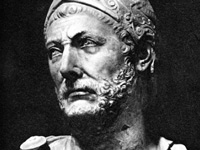 Hannibal Barca (247-183 BC), was a Carthaginian general, considered one of the greatest military commanders in history. Hannibal lived during a period of great tension in the western Mediterranean Basin, when the Roman Republic established its supremacy over other great powers such as ancient Carthage. One of his most famous achievements was at the outbreak of the Second Punic War, when he marched an army which included war elephants from Iberia over the Pyrenees and the Alps into Italy. Hannibal Barca » time to march from the Ebro to the Rhone.
Hannibal Barca (247-183 BC), was a Carthaginian general, considered one of the greatest military commanders in history. Hannibal lived during a period of great tension in the western Mediterranean Basin, when the Roman Republic established its supremacy over other great powers such as ancient Carthage. One of his most famous achievements was at the outbreak of the Second Punic War, when he marched an army which included war elephants from Iberia over the Pyrenees and the Alps into Italy. Hannibal Barca » time to march from the Ebro to the Rhone.
After evading a pitched battle at the Rhone, Hannibal came to the aid of his Gallic allies, who were hard pressed by the Roman reinforcements. He crossed the Alps, surmounting the difficulties of climate and terrain, and the guerrilla tactics of the native tribes. His exact route is disputed. Hannibal arrived with at least 28,000 infantry, 6,000 cavalry, and 30 elephants in the territory of the Taurini, in what is now Piedmont, northern Italy. While this crossing was expected by the Romans, they had not anticipated such an early arrival and their forces were still in their winter quarters. Hannibal's crossing of the alps, is considered one of the greatest achievements in military logistics, as he did so through hostile territory in late autumn with no supply line. His surprise entry into the Italian peninsula led to the termination of Rome's main intended thrust, an invasion of Africa.
The Gauls of the lower Po Valley, Hannibal's allies, were still far away. Hannibal was first obliged to fight with his currently reduced force to reach them and incite the rest of Gallia Cisalpina to revolt. His first action was to take the chief city of the hostile Taurini (in the area of modern day Turin). Afterwards, the Carthaginians were intercepted by a newly raised Roman force under Publius Cornelius Scipio. Hannibal had evaded earlier him in the Rhone Valley. In the ensuing Battle of Ticinus, the cavalry forces of Hannibal's army defeated the cavalry and light infantry of the Romans in a minor engagement. Scipio, severely injured in the battle, retreated across the River Trebia with his heavy infantry still intact, and encamped at the town of Placentia to await reinforcements. As a result of Rome's defeat at the Ticinus, all the Gauls except the Cenomani were induced to join the Carthaginian cause. Soon, the entire north of Italy was unofficially insurgent, with both Gallic and Ligurian troops bolstering Hannibal's army to at least 40,000 men.
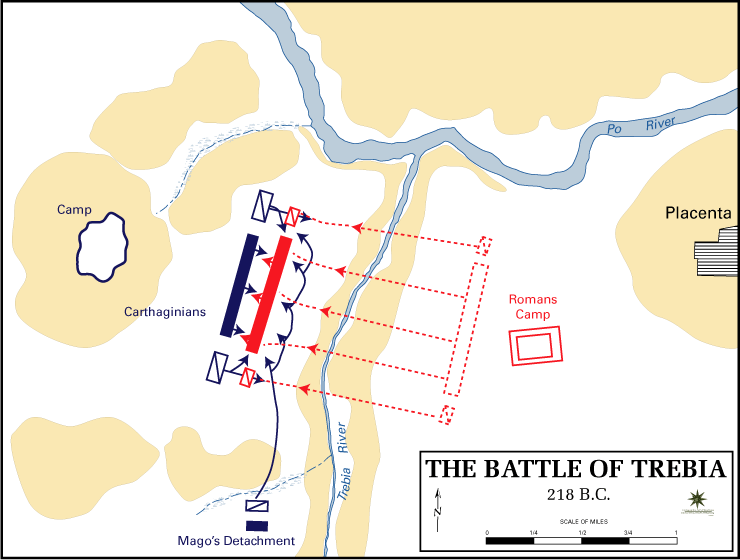
The battle of Trebia, 218 B.C., second Punic War, between Carthaginians and Romans

The battle of Trebia, 218 B.C., second Punic War, between Carthaginians and Romans
( Click image to enlarge)
Even before news of the defeat at the Ticinus River had reached Rome, the Senate had ordered the consul Sempronius Longus to bring his army back from Sicily, where it had been preparing for the invasion of Africa, to join Scipio and face Hannibal. Hanibal was blocking Sempronius' way to Scipio's army. However, the Carthaginian capture of the supply depot at Clastidium, through the treachery of the local Latin commander, served as a diversion and allowed Sempronius' army to slip through to Scipio, who was still too seriously injured to take the field. After some minor successes, the united and numerically equal Roman force under the command of Sempronius Longus was lured into combat by Hannibal at the battle of the Trebia. The Roman troops were drawn into the engagement without breakfast and first had to cross a cold river, preventing many from putting up much of a fight. Furthermore, a hidden detachment led by Hannibal's younger brother Mago attacked them from the rear. All in all, the Romans suffered heavy losses with only 20,000 men out of 40,000 able to retreat to safety. They left Cisalpine Gaul in the aftermath. Having secured his position in northern Italy by this victory, Hannibal quartered his troops for the winter amongst the Gauls. The latter joined his army in large numbers, bringing it up to 60,000 men; their enthusiasm was somewhat reduced due to the Carthaginians living on their land.
The Roman Senate resolved to raise new armies against Hannibal under the recently elected consuls of 217 BC, Gnaeus Servilius Geminus and Gaius Flaminius Nepos. The latter had long distrusted his fellow senators and feared that they would try to sabotage his command by finding excuses to delay his departure. So he quietly left Rome to take over his army at Ariminum without performing the lengthy religious rituals required of an incoming consul. The Senate voted unanimously to recall him, but he ignored its orders. This caused widespread dismay among the Romans, who feared that Flaminius' disrespect for the gods would bring disaster on Rome. As it was expected that Hannibal would advance into central Italy, Flaminius moved his army from Ariminum to Arretium, to cover the Apennine mountain passes into Etruria. His colleague Servilius, who had performed the proper rituals and was therefore well behind Flaminius, replaced him with his freshly raised army at Ariminum to cover the route along the Adriatic coast. A third force, containing the survivors of previous engagements, was also stationed in Etruria under Scipio. Thus both the eastern and western routes to Rome appeared guarded.
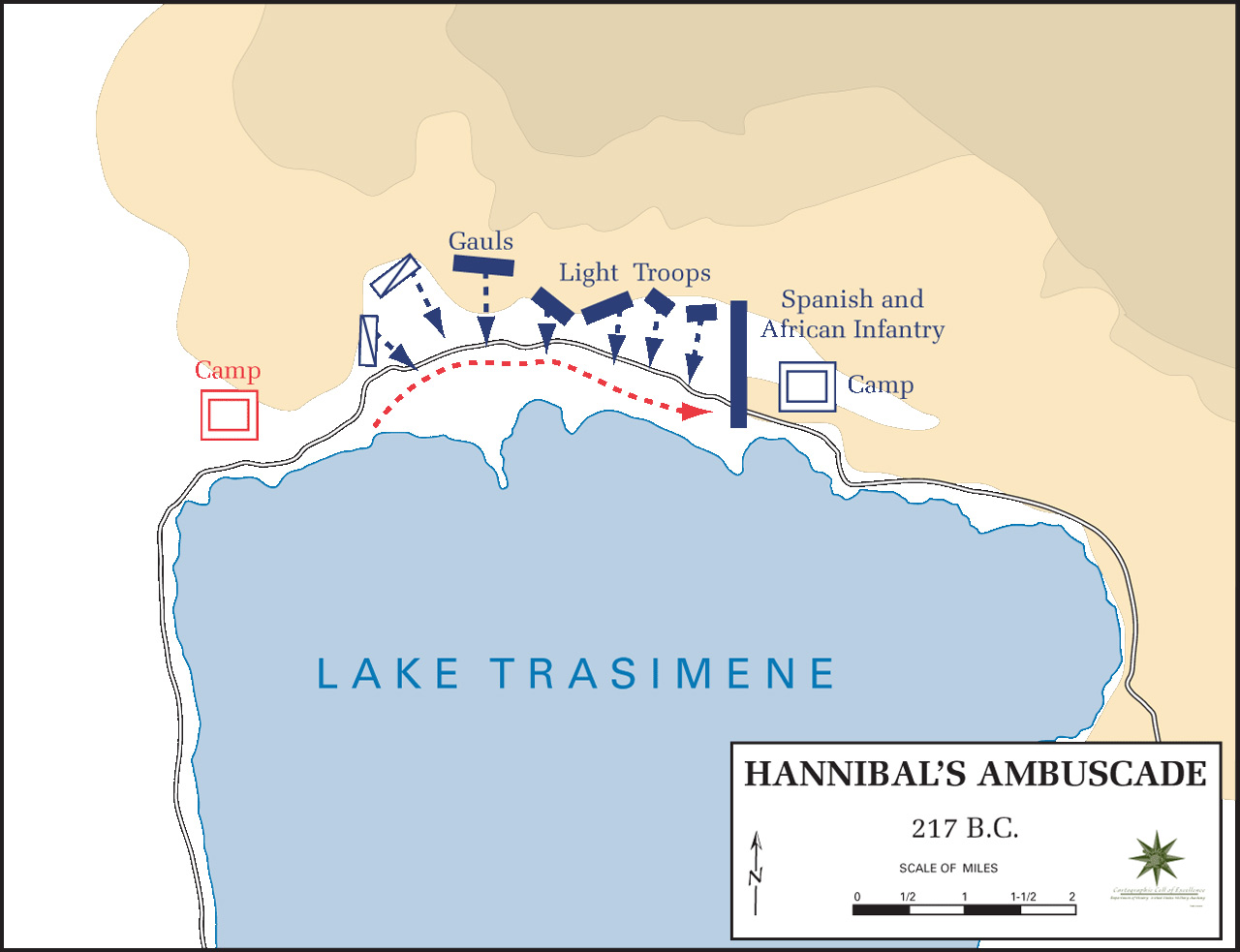
Battle of Lake Trasimene, Hannibal's ambuscade

Battle of Lake Trasimene, Hannibal's ambuscade
( Click image to enlarge)
In early spring 217 BC, Hannibal decided to advance, leaving his wavering Gallic allies in the Po Valley and crossed the Apennines unopposed. He avoided the Roman positions and took the only unguarded route into Etruria at the mouth of the Arno. This route was through a huge marsh, which happened to be more flooded than usual for spring. Hannibal's army marched for several days without finding convenient places to rest, suffering terribly from fatigue and lack of sleep. This led to the loss of part of the force, including, it seems, the few remaining elephants.
Arriving in Etruria, still in the spring of 217 BC, Hannibal tried without success to draw the main Roman army under Flaminius into a pitched battle by devastating the area the latter had been sent to protect. Hannibal then employed a new stratagem, when he marched around his opponent’s left flank and effectively cut him off from Rome. Advancing through the uplands of Etruria, the Carthaginian now provoked Flaminius into a hasty pursuit without proper reconnaissance. Then, in a defile on the shore of Lake Trasimenus, Hannibal lay in ambush with his army. The ambush was a complete success: in the battle of Lake Trasimene Hannibal destroyed most of the Roman army and killed Flaminius with little loss to his own army. 6,000 Romans had been able to escape, but were caught and forced to surrender by Maharbal's Numidians. Furthermore, Scipio, aware of the fighting, sent his cavalry in support but it was also caught and annihilated. As a result of this victory, the heterogeneous force of insurgent Gauls, Africans, Iberians and Numidians had more military equipment than they could use themselves and sold the surplus via Egyptian traders to the Romans. Like after all previous engagements, the captured enemies were sorted according to whether they were Romans, who were held captive, or non-Romans, who were released to spread the propaganda that the Carthaginian army was in Italy to fight for their freedom against the Romans. Strategically, Hannibal had now disposed of the only field force that could check his advance on Rome; but, despite the urgings of his generals, he did not proceed to attack Rome. Instead, he marched to the south in the hope of winning over allies amongst the Greek and Italic population there.
Related Articles
First Punic War (264-241 BC)
The first of three wars fought between Ancient Carthage and the Roman Republic. For more than 20 years, the two powers struggled for supremacy, primarily on the Mediterranean island of Sicily and its surrounding waters, and also in North Africa. View First Punic War (264-241 BC) »
Second Punic War (218-201 BC)
The Second Punic War, also referred to as The Hannibalic War and (by the Romans) the War Against Hannibal, lasted from 218 to 201 BC and involved combatants in the western and eastern Mediterranean. View Second Punic War (218-201 BC) »
Third Punic War (149–146 BC)
Was the third and last of the Punic Wars fought between the former Phoenician colony of Carthage and the Roman Republic. This war was a much smaller engagement than the two previous Punic Wars and focused on Tunisia. View Third Punic War (149–146 BC) »
HISTORY
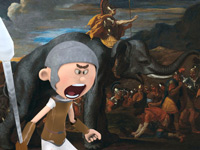
RESOURCES
This article uses material from the Wikipedia article "Second Punic War", which is released under the Creative Commons Attribution-Share-Alike License 3.0.
© Stories Preschool. All Rights Reserved.
